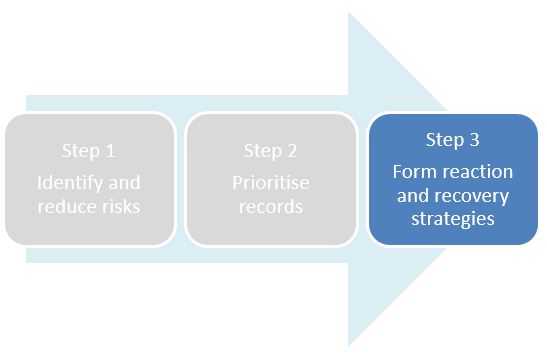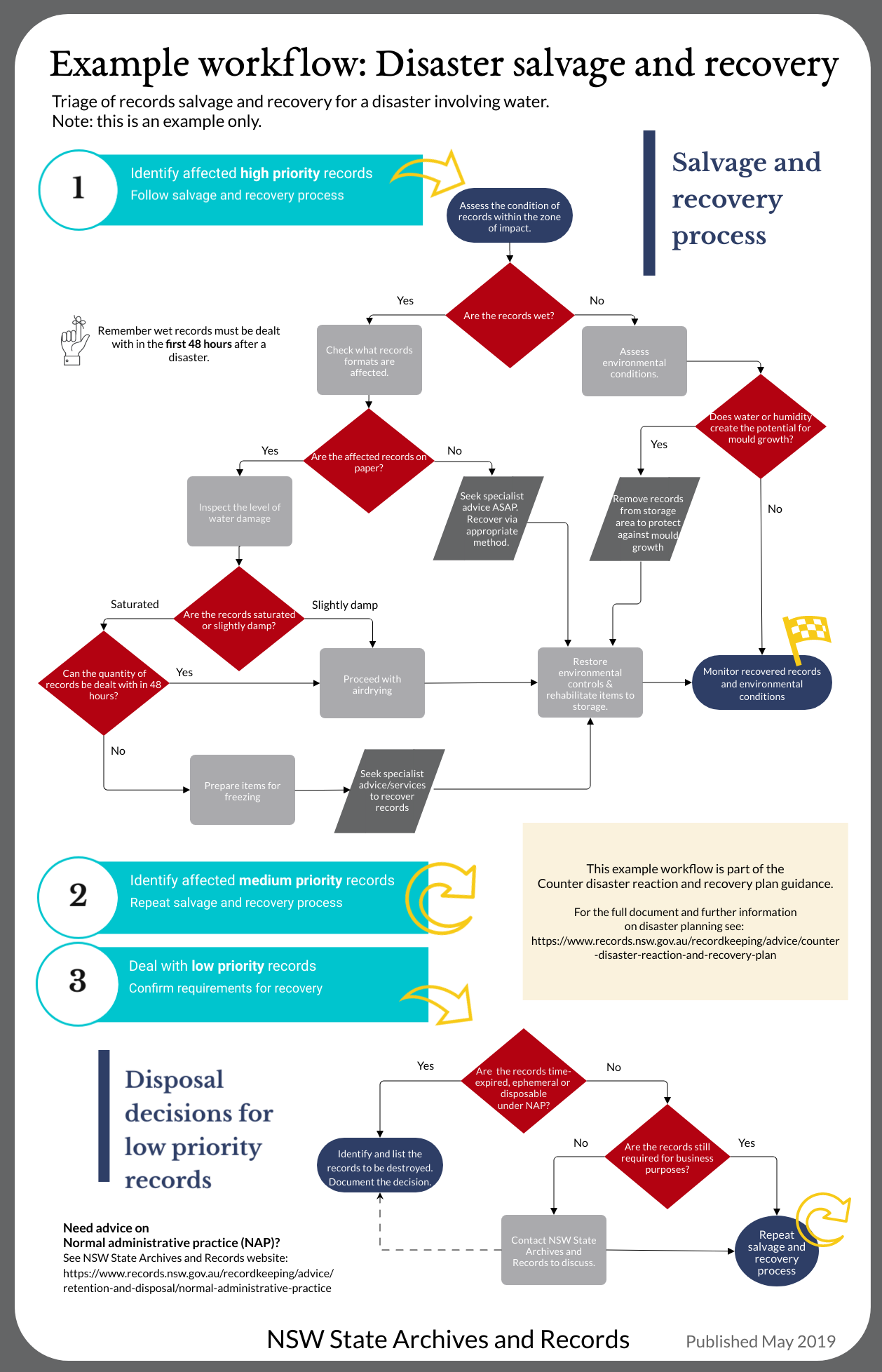About: This advice refers to physical records. The storage of digital records on network servers, in data centres, or in the cloud is NOT covered by the scope of this guidance. The protection and recovery of digital records needs be addressed within your Public Office’s business continuity plan.
Step 3. Develop response strategies

A reaction and recovery plan strategy outlines basic procedures and provides guidance to follow prior to a potential disaster and in the aftermath.
When developing strategies consider:
- impact on the wider community
- scenarios which are both highly probable and have high impact
- scalability of the disaster, and
- additional resources required for salvage and recovery.
When developing procedures consider:
- procedures for the identification and reporting of a disaster situation
- functions and chain of command for salvage and recovery teams
- priority records and their locations
- how to triage priorities
- handling of damaged materials
- equipment and materials available
- testing requirements, and
- staff training.
Resources for formulating detailed reaction strategies will be best spent on scenarios which are both highly probable and have high impact. Consider the resources available to your organisation to ensure your plan is realistically actionable. Scalability concerns, like the need to procure additional resources or external assistance should also be flagged where appropriate.
Remember, the impact a disaster has on the wider community can affect your organisation’s ability to respond, e.g. if a wet weather event such as heavy rain and flooding has affected the local area, many organisations and members of the community are also likely to be affected and this may reduce your organisation’s capacity to respond to the disaster.
5.1 Formulating procedures
Staff will be under pressure in a disaster situation therefore procedures must be clear and easy to follow.
Reaction procedures should be accompanied by supporting documents, including insurance policies, formal agreements, contact details of stakeholders and staff, and lists of potential assistance providers.
Remember, some information will need to be held separate to the procedures due to the information it contains on security arrangements and high priority records.
| Relates to | Procedures need to outline | Supporting documents may include | ||
|---|---|---|---|---|
| Chain of command |
chain of command in the event of a disaster (this will vary from the usual organisational hierarchy) including who is (or could act as) the disaster co-ordinator the disaster co-ordinator’s has the responsibility to declare a disaster situation and initiate response procedures |
contact details of the disaster response coordinator and team (contact tree) contact details of Work Health and Safety co-ordinator |
||
| Disaster Alerts | how to respond to pre-warnings and alerts issued by Emergency Services prior to an actual event occurring (e.g. storm warnings or bush fire alerts) | contact details of nearby emergency services | ||
| Initial reactions |
how to assess the condition of the site and ensure that it is safe to enter (you may need to coordinate with Emergency Services depending on the type and severity of the disaster) situations in which a disaster is to be declared and the relevant authorities to contact. how to make best use of disaster bin contents |
building plans showing storage areas, locations of disaster bins, exits, extinguishers, alarms, master switches location details for master keys NOTE: the above information should be kept secure and separate from the disaster plan. Access to this type of information should be limited to disaster co-ordinators. |
||
| Insurance information |
when to advise the insurance company of an incident recovery techniques that are not be used on State records or State archives |
contact details of insurance agent Protocol for insurance assessors (produced by NSW State Archives and Records) |
||
| Notification to NSW State Archives and Records | when to advise NSW State Archives and Records if there is damage or loss to records as a result of a natural disaster, storm, flooding, fire, contamination or technology disruption | contact details for NSW State Archives and Records | ||
| Emergency arrangements |
work health and safety requirements and instructions how or where to procure an alternative site what to do about site security and access |
contact details of WH&S Co-ordinator details of potential alternative sites and any documented agreements |
||
| Human resources |
when and how to bring in staff for assistance how to co-ordinate salvage teams how to manage staff overtime (e.g. legal & WH&S requirements) how to procure temporary staff how to manage volunteers |
contact details of HR co-ordinator policies and procedures relating to labour hire policies and procedures relating to management of volunteers |
||
| Communications |
how to distribute internal communications how to distribute external communications how to manage media enquires |
communications and/or media policy | ||
| Priority records |
how to identify and locate priority records how to triage priorities to salvage and recovery affected records (download PDF for example of a triage method) |
appraisal statement retention and disposal authorities building plans showing storage areas and the location of high priority records (restricted access to this documentation) inventory list of priority records and their storage locations (restricted access to this documentation) |
||
|
Record assessment |
how to document damage to records how to handle damaged records how to deal with access restrictions or security measures applied to records |
records assessment template | ||
| Damaged records |
how to authorise disposal of time-expired records basic recovery advice for burnt, soiled, damaged, or wet records recovery techniques that SHOULD NOT be used on State records how to deal with records beyond recovery instructions for rehabilitating records back into storage |
applicable retention and disposal authorities contact details for NSW State Archives and Records copy of NSW State Archives guidance for records recovery Protocol for insurance assessors (produced by NSW State Archives and Records) |
||
| Additional resources |
expertise, equipment and alternative sites potentially needed emergency procurement processes |
lists of available equipment and expertise list of vendors and suppliers who can provide additional equipment and/or services contact details of records disaster recovery specialists and conservators (lists should note their areas of expertise) |
||
Additional actions or further information may be needed to tailor the plan to your specific requirements or a particular disaster scenario.
It may also be appropriate to include decision trees within your response plan (e.g. if electricity is available then…, if electricity is not available then…).
5.2 Responding to disaster alerts
When severe weather is forecast (e.g. high fire danger rating, storm warnings) additional site monitoring and maintenance activities should take place before and after.
Prior to severe weather it is important to ensure that pipes, gutters and other emergency systems are fully functional. Check that disaster bins are in the correct locations and fully equipped.
Additional monitoring should also take place in the first 24 hours after severe or wet weather to ensure that no damage has occurred to records and/or the building. This would involve checking a sample of records and their package, at each storage area within the site(s).
5.3 Declaring a disaster
Guidance outlining situations in which a disaster is to be declared and the relevant authorities to contact needs to be included in the plan. It is the disaster co-ordinator’s responsibility to declare a disaster situation and initiate response procedures.
Remember, if a disaster affects records, and there has been damage or loss to records, your organisation must notify NSW State Archives and Records.
If mould is identified and is affecting records, NSW State Archives and Records must be notified and the problem must be treated promptly.
5.4 Site assessment
Procedures for assessing the extent of site damage after a disaster should be incorporated into plans. In larger scale disasters this may include gaining the approval of emergency services personnel, WorkCover officials, and/or professional tradespersons.
5.5 Site security
Securing the site and any alternative sites used for recovery is important. Failure to secure a damaged site leaves it vulnerable to unauthorised access, theft and vandalism and puts the organisation at risk of suffering further loss.
Disaster and recovery sites can increase security by:
- creating a list of authorised leaders and personnel
- issuing identification badges to authorised personnel
- organising a sign in and out sheet (this can record time worked as well)
- locking doors and boarding up windows in unmonitored areas
- installing signs designating restricted areas
- hiring security patrols
- seeking police assistance
5.6 Salvage teams
In a large scale disaster it may be appropriate to have multiple teams performing concurrent disaster recovery operations. Response strategies can include guidance, suggested duties, and basic procedures for team operations and formulation a workflow.
| Team | Task |
|---|---|
| ↓ Clean up team | Clears obstacles in storage areas |
| ↓ Salvage team | Retrieves items from storage, notes locations and basic identifying information |
| ↓ Evaluation team | Establishes retention requirements, prioritises records for recovery, documents damaged items |
| ↓ Packing team | Prepares items for transit and/or freeze drying |
| ↓ Air drying team | Recovers wet records |
Records can move through the workflow whilst activities take place con-currently. Once recovered a process can then be formulated for rehabilitating items to storage.
5.7 Sourcing additional resources, supplies and expertise
Planning also includes identifying suppliers and services which may be able to provide assistance in the event of a disaster and compiling a contact list for reference when required.
This list may include:
- equipment providers or hiring companies
- vehicle hire companies
- suppliers of boxes and other archival materials
- commercial records recovery services
- conservators (note area of expertise)
- trades persons
- labour hire companies.
It may appropriate to form agreements with other organisations for example, loan of work space, temporary storage space or staff in the event of a disaster.
5.8 Dealing with damaged records
Planning includes developing procedures for dealing with specific types of damaged records. For example wet records must be dried within 48 hours to avoid the risk of mould growth, badly burnt records are fragile and need to be handled gently, and records contaminated by chemicals or sewerage pose health risks and should not be handled.
Remember that personnel must wear Personal Protective Equipment (PPE) if dealing with mouldy, dirty or contaminated records. This will include masks with either a P1 or P2 filter, plastic gloves, apron, and eye goggles.
Reporting of damaged records to NSW State Archives and Records is a requirement of the Standard on the physical storage of State records and should be clearly outlined within written procedures.
If records are:
- damaged or there has been loss of records, or
- not covered by retention and disposal authorities, or
- identified as State archives
then you must make contact as soon as possible to discuss the affected records. Phone (02) 9714 3080 or email govrec@records.nsw.gov.au.
It is important not to assume records are unsalvageable or rush to dispose of damaged records, NSW State Archives and Records can provide further advice on how to deal with damaged records.
Procedure for dealing with damaged records should include:
- contacting NSW State Archives and Records
- how to authorise disposal of time-expired records
- basic recovery advice for burnt, soiled, or wet records
- recovery techniques that are NOT be used on State records
- how to deal with records beyond recovery
- instructions for rehabilitating records to storage
The information contained in the reaction and recovery sections of this document provide guidance on how to record damage to records, how to authorise disposal of time-expired records, as well as advice for handling damaged records and recovery techniques, which be used to inform disaster response and recovery procedures.
Refer to reaction and recovery.


